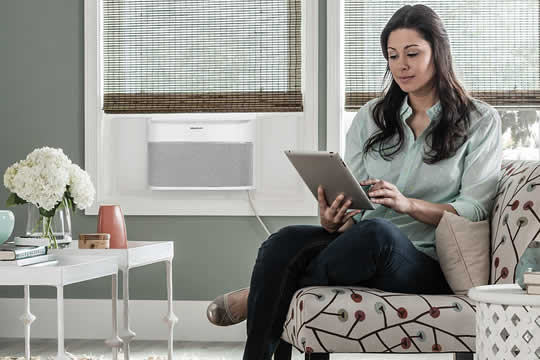Self Contained Air Conditioners
The popular form of self contained air conditioners can be seen in many homes, most often as window or portable AC units that keep our rooms cool during summer without costing the earth to buy and install.
I want to take a look at this type of cooling device in this article to show their strengths and weaknesses, advantages and disadvantages (pros and cons) and why they are so popular in so many households.
 All types of this particular variation of air conditioning device boil down to providing you with a viable solution to keeping you and your family and your home nice and cool during the heat of summer.
All types of this particular variation of air conditioning device boil down to providing you with a viable solution to keeping you and your family and your home nice and cool during the heat of summer.
They can similarly be used to effectively keep you and your co-workers cool in your work place if this happens to be a smaller building or suite of offices, for example. So if you want to find out more about self contained air conditioners, you are in the right place!
Overview
To begin with, here is an an overview of the appliances that I'm covering.
The type of cooling unit I'm looking at in this article is the fully self-contained or single unit air conditioner that you can buy in stores and online. These units are generally quite easy to install if you possess even basic handyman skills and the tools to match.
In this category of cooler are the ever-popular portable air conditioners, as well as window air conditioners. It also extends to PTAC and VTAC units that are also covered here. Let's look at what these devices actually are.
What Are Self Contained Air Conditioning Units?
What are best described as being fully self-contained air conditioners are those individual cooling appliances that have all the mechanical works enclosed within a single, stand-alone unit or box.
These are fully operative air conditioning units pre-charged with the ozone-friendly R32 refrigerant gas. They come ready to use right out of the box for indoor living or working applications in residential or commercial locations where there are people that need to have a comfortably stable interior climate in which to live or work.
For simplicity's sake, I'll cover the domestic indoor units that can be commonly observed installed in homes. Let's start with the free standing portable AC units.
Portable Air Conditioners
Portable air conditioning units are the hugely popular free standing appliances with wheels for portability. They are designed to be easily rolled from one room to another as they are needed.
Portable AC units have extendable, flexible vent hoses (one or two, depending on model) that are connected to a specially molded window vent. Its purpose is to allow the extraction of the hot air produced by the unit as part of the refrigeration process.
An interesting development in modern portable AC devices is self evaporating technology that effectively eliminates the chore of having to regularly empty a water container except in particularly humid conditions, as is common with non-self evaporating models.
At the top of the technologically advanced hierarchy come the WiFi enabled, smart air conditioners that can be controlled via a smart phone app or with a so-called digital home assistant such as Alexa.
Window Air Conditioners
Window AC units are also a relatively common feature in homes, especially in apartment blocks. These are installed in a window opening and provide a fixed, single room cooling solution.
These compact cooling units are designed primarily to maintain a cool temperature in a single room in the home.
Being semi-permanently mounted in a suitable window frame, the venting of hot air is achieved directly to the outside through a vent located on the exterior side of the unit. The draining of condensate is also done directly to the outside, usually via a convenient drip tube.
PTAC and VTAC
Another form of self-contained AC device is the package terminal air conditioner (PTAC) and also the vertical terminal air conditioner (PTAC).
These units are commonly installed in hotel or motel rooms, hospital and health center rooms, mobile homes or other public buildings and commercial properties.
PTAC units are typically installed beneath a window in a room, whereas VTAC units because of their orientation are installed inside vertical closet or cupboard spaces where they are easily concealed from the room they operate in.
These units can also be installed outside the building, being connected via the air ducting network.
Their main appeal especially in public dwellings is their robustness and reliability along with their ability to maintain a steady, cool temperature in a room despite high temperatures outside.
Self Contained vs Split and Central AC
The most obvious way a self-contained AC unit differs from split-system units or central air systems is that all it's mechanics are housed inside a single unit.
Split-systems are comprised of two or more separate units, with an indoor compressor unit that provides the cold air to circulate around the room and an outdoor evaporator/condenser unit to handle the removal of hot air and moisture from the indoor air.
The individual components of split systems are generally connected by through-wall ducting and work in tandem to provide the cold, conditioned air inside the home or office building.
Split systems provide a powerful cooling system for larger rooms , whereas central air or HVAC systems service the whole building's climate.
Central air systems have their main components housed in a larger cooling and heating unit inside the building with an evaporator/condenser unit outside. These systems are designed to control the indoor temperature of the whole building, whether it is a domestic home or a commercial space and have air ducts that service the entire building, room by room.
Generally, split AC and central air systems tend to cost more to purchase and install than smaller, more compact self contained AC units.
Evaporative Cooling Units
Another variation of self contained cooling appliance is what is often referred to as a ventless air conditioner. This type of cooler is actually an evaporative cooler (swamp cooler).
These are not refrigerant-based coolers, but differ from an air conditioner by creating cool air using the evaporation of water. This is a relatively cheap to run process, since there is far less mechanical operation and therefore less electricity consumption.
The internal pump and fan are generally the only internal items that require power, making swamp coolers consumers of typically 1/20th the energy that a similar size and output rated air conditioner would use.
Evaporative coolers come in both portable units and also window-mounted units, offering the respective advantages of each type of installation, especially with regard to the portable variety that require no vent hose (hence the misnomer, ″ventless air conditioner″).
However, while the very low energy consumption and eco-friendliness of evaporative coolers is an obvious advantage, there is one major disadvantage of this type of cooler.
This is that they don't work at all well in humid conditions. In such conditions, an AC is by far the better choice of cooling solution.
Heating and Cooling
Some self-contained AC models are equipped with cooling and heating systems, offering all year round provision of comfortable indoor temperature, regardless of the weather outside.
A big plus of this type of indoor heater/cooler is that it represents a lower cost purchase, since only a single unit is required instead of separate heating and cooling units for different seasons.
Portable AC units (with heat) are especially versatile as they can be moved to different locations depending on which rooms are occupied by people at the time. This is more economical than running, say, central sir to keep the whole house cool (or warm) when there is only one or two people occupying a single room and the rest of the house is empty.
In this respect, a single portable AC can sometimes be better (and a lot cheaper) than buying multiple cooling units, one for each room.
Summing Up
Whichever cooling solution you settle upon to keep you cool in summer will ultimately depend upon your budget and what you can afford at the time.
Choosing self contained cooling units, whether portable or window mounted, can represent an economical option for homes that lack central air or distributed split systems installed.
These appliances are great spot coolers or temporary cool-boosters for the odd times when the weather is exceptionally hot and portable units can even be at home in covered porches or summer houses (gazebos).
Whichever type of individual, self-contained AC unit suits your requirements and budget, they are great cooling solutions that will provide the cool comfort you need, where you need it and when you need it.
[BACK TO TOP]
